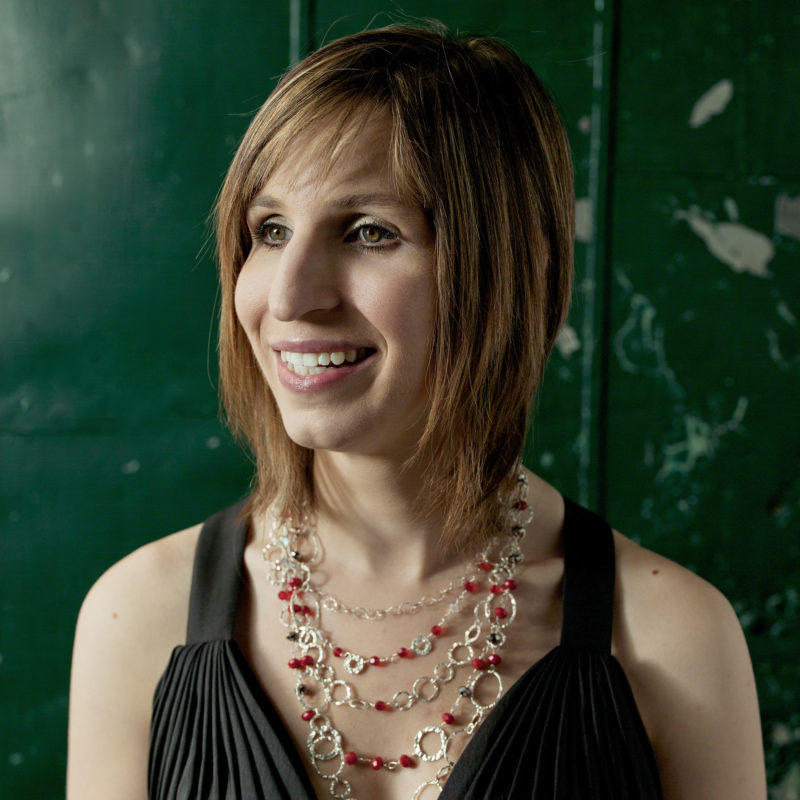
What do colors sound like? Ahead of this weekend’s world premiere of Lisa Bielawa’s song cycle Centuries in the Hours in Time For Hope, we had a chance to sit down with mezzo-soprano Laurie Rubin – who has been blind since birth – to explore how she sees the world, yielding a unique, and deeper way, of musical collaboration. Read on for more, in this ROCOInsider!
This will be the second time you’ve worked with Lisa – what do you love most about collaborating with her? How did the connection for this commission come about?
I first met Lisa many years ago at a workshop pairing young singers and composers, hosted by composer John Harbison and singer Dawn Upshaw. Though we weren’t paired together, I absolutely loved hearing her piece Hurry (for soprano, flute, clarinet, violin, cello and piano) and getting to know her, and we kept up with each other in the years following.
In 2013, I happened to run into her at an opera performance – she told me she was working on her own opera at that time, and I asked if I would play a role in it.
Lisa’s opera, Vireo: The Spiritual Biography of a Witch’s Accuser, was a fascinating take on how teenage-girl visionaries were unfairly treated and manipulated by the men around them throughout history. It was here that we discovered how wonderfully we worked together.
The opera was made for TV, filmed as episodes in various locations, and the last filming took place in 2017 – just before I began to read articles about the #MeToo movement, with women coming out about instances of people in power, even in the classical music industry, who threatened their careers. I was deeply disturbed by that.
A few days later, I wrote to Lisa and said, we should do something – we should look at working together on a piece that really puts emphasis on the lives of women, and their voices.
Lisa shared that she would have a research fellowship upcoming at the American Antiquarian Society for another piece and that she’d love to use some of that time to look at creating an orchestral work that I would sing.
Just a few months later, the connection was made with ROCO – and when we learned how ROCO is completely run by women and celebrates the work of women, it was so fitting. We are so incredibly excited for this opportunity to premiere this work, and that it’s with ROCO.
In this work, you embody five different characters – a group of very diverse women. What has it been like getting to know them through their writings?
It’s interesting because, we tend to think that because they lived in such a different era, that their lives are so different than ours – but you realize that, at heart people really haven’t changed, their desires haven’t changed, and who we are as humans has not changed.
For example, with Angeles Raymundo (the 3rd movement) – she is so optimistic and looking forward to moving to America, but she talks about being sad because she will miss a friend she is leaving – this is so familiar and so relevant.
Or for Sally, the teenage girl who is bored, and kind of a melodramatic teenager – she’s someone we all recognize!
But there are definitely certain things they reference that give you a sense of how much more difficult their lives were back then compared to ours, such as being very susceptible to illness, there was really a lot they had to endure.
And another big difference compared to now – is that all of these writings are journals or diary entries actually written on paper – there is something so romantic about that, and deliberate about the language, influenced by the fact they’re writing on paper. It’s sad that we almost don’t have that anymore, everything has become so digital and so instant with email.
During the writing of the piece, how much did you and Lisa collaborate – did she send over movements to look at as they were completed?
She did send me a couple of movements early on, one being of Angeles – because she was a Filipina living in Hawaii, where I live now – and her story is so typical of Hawaiian culture, and of a lot of Filipino families from that time. I loved how Angeles talked about playing the ukulele, and that she lived in the time when my wife’s grandmother was being raised here.
It was so interesting to see how Lisa went about whittling down all the writings to five women. She also asked me during the selection what would I want to sing text-wise, which helped as well. I loved how she tried to really include me and consider me in the process of writing – it’s amazing to collaborate with Lisa because it’s always so apparent how much she cares about the artists she works with.
When it comes to learning a new work – how do you approach learning a piece of music, without sight? Do you use a braille score, or the piano to help learn?
With new music, I mostly learn by ear, going off of a mock-up recording – there is braille music and I use it to a limited extent, but I find it to be a bit cumbersome because you can only look at one line, you can’t look at the whole score or big picture.
The piano is also very helpful – I actually have a good sense of what the visual staff looks like from others’ descriptions, so I may have others go through where each note is on the staff and play it for me, and to me, this is much more effective than braille music alone.
When you work with an ensemble – what signals help you most to cue off of, and stay in sync with the musicians?
I listen for the musicians’ breathing, the sounds they make while playing – their movement, their bowing, their energy – and cue from that.
That is one reason I really love chamber music, you forget about yourself as a solo artist and start to think of yourself as an artist in conjunction with others, a part of the tapestry going on around you – and it’s such a rewarding experience.
You have written a memoir, titled Do You Dream in Color? Insights from a Girl Without Sight – and in it you describe how you can actually see, in a sense, colors – are there any specific colors you would associate with the different characters in Centuries in the Hours?
Oh, I haven’t thought about that! I would associate colors not necessarily with each character, but I really associate specific colors with different musical keys – for example, to me – the key Bb is a rich chocolate brown, and the key of A is green, but then F#, the relative minor – is more of a bright yellowy-green.
If I had to associate a color with any of the characters though, Angeles comes to mind as she’s so bright and cheerful – so I do think of a bright green or yellow, and tropical colors since she’s from Hawaii!
In addition to performing around the world, you also teach actively – and founded your own arts school, Ohana Arts, with your wife Jenny. How did it get started?
Jenny, who is from Hawaii, really had a dream of someday opening a school there, as she had attended Interlochen Arts Academy, and I myself attended the Boston University Tanglewood Institute, and were both so inspired by our experiences. As an artist, you realize at a point that it’s truly all about giving back.
Every time we visited Hawaii – we were struck by how community-focused the culture is, everything you do has such an impact. (The name of our school also reflects this, as ohana means “family” in Hawaiian!) We wanted to make the same opportunities available for young people in Hawaii as we had, even if they didn’t have the means. It’s so expensive to travel to the mainland from Hawaii, a lot of kids can’t afford to travel to the music festivals and academies there, so we wanted to bring a high-quality arts education straight to them.
We started the school while we still lived in New York, but realized at some point that we had to make the move to Hawaii to really grow. It began with just 20 students in the program, and has now grown to 105 students last year – we even have some students from the mainland states, and internationally, and we serve students of all abilities. As an artist, you realize at a point that it’s truly all about giving back.
If you could give advice to a young person with disabilities who would like to pursue an arts education or career, what would it be?
Really the most important thing is to find a true, unconditionally supportive mentor, who you can lean on for advice and guidance – and also, just don’t give up. Know what you want, and find out what it takes to get there. Never forget what your dream is. Life is never easy for anyone – and the best thing you can do is to put the hard work in the things that you love.
 Hear Laurie in the world premiere of “Centuries in the Hours” – commissioned by ROCO and The ASCAP Foundation Charles Kingsford Fund – in ROCO In Concert: Time For Hope, on Friday, September 27, 2019 at Miller Outdoor Theatre, 8:00 pm (free admission), and Saturday, September 28, 2019, 5:00 pm, at The Church of St. John the Divine. Tickets available at roco.org, or at the door.
Hear Laurie in the world premiere of “Centuries in the Hours” – commissioned by ROCO and The ASCAP Foundation Charles Kingsford Fund – in ROCO In Concert: Time For Hope, on Friday, September 27, 2019 at Miller Outdoor Theatre, 8:00 pm (free admission), and Saturday, September 28, 2019, 5:00 pm, at The Church of St. John the Divine. Tickets available at roco.org, or at the door.

Leave A Reply